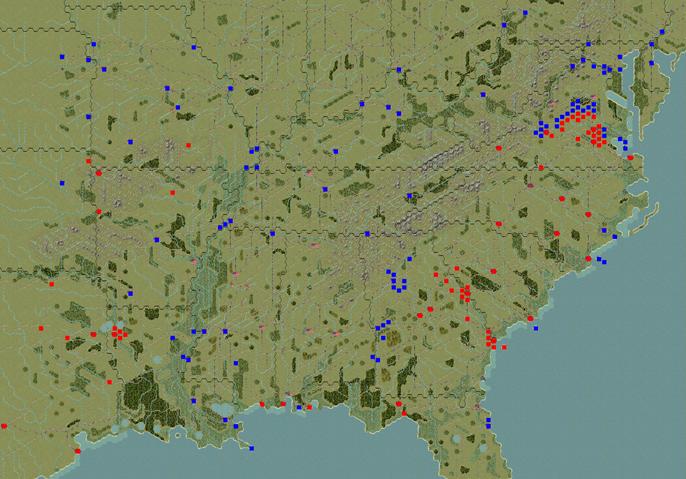Raindem
Posts: 696
Joined: 7/15/2000
From: Arizona
Status: offline

|
Spring 1865
Turns 103-End
The scenario nominally ends on Turn 106 (April 22, 1865). But there is an event which can end it up to 4 turns earlier or later. This puts a little uncertainty into the scenario ending and helps discourage last turn suicide attacks.
Winter’s final snows hadn’t even yet melted when all Union forces in the east resumed offensive operations against Confederate positions around Richmond. The first part of the shell to crack was on the Peninsula. After four years of holding back Union forces there, the line finally gave way and troops from the Army of the James (Butler) arrived at the outskirts of Richmond. Longstreet was sent to bolster the line. A successful counterattack stabilized the positions east of Richmond. But with Longstreet’s corps gone, the positions north of Richmond started to falter as well.
The Union Department of Viriginia then started applying pressure on the west facing of the perimeter by attacking at Lynchburg. Next, the small force at Beaufort, organized as the Union Department of North Carolina (Foster), broke away from the coast and captured New Bern. The Confederate Department of North Carolina (Holmes) was in Raleigh and rushed forces to Goldsboro to check any further Union advance.

The game ended just a couple turns after the above screenshot was taken (Turn 104, March 25, 1865), and resulted in a Draw. The Confederacy had a 17 VP advantage. They needed 20 for a win.

Total casualties were as follows:
Union: 481,826 men, 398 guns, 77 warships
Confederacy: 313,924 men, 1,424 guns, 8 warships
Proportionally, this isn’t too far off from historical results (Union: 350k Conf: 250k). But it always gets a little muddy translating TOAW equipment destroyed into actual KIAs. In this scenario each infantry type Company represented 100 men and each gun was served by a crew of 12 (24 if it had horse drawn transport). Each warship was considered to have a 100-man crew.
The screen shot below shows the ending location of all units for both sides. In addition to the border states, all of Tennessee, Mississippi, and Alabama were Union occupied, as were the largest cities in Arkansas and Louisiana. Florida and Georgia were still about 50/50.

Some would argue this should be a Confederate victory since they kept the Federals out of Richmond and most of the Carolinas. Others might argue for a Union victory since two-thirds of the South had been overun, their armies defeated, and 4 of their largest 5 cities captured. Victory conditions are always a challenging component of scenario design, especially in a conflict such as this where historically one side did achieve an overwhelming victory. I attempted to strike a balance here between matching historical results and achieving actual results. The Union clearly didn’t deserve a victory here by historical standards. But the fact that the Confederacy didn’t get whooped as bad as they did in real life wasn’t enough to warrant a victory for them either. Hence, a draw.
It should be noted that the Confederacy had a 5 point loss penalty and the Union had zero. Loss penalties in this scenario tend to range between 0 and 20. If the Confederacy had reduced its casualties or inflicted a few more on the Union, it might have been enough to give them the victory.
Post Game Analysis
The primary reason for the Union underperforming was the delays they encountered in the western theater. By the skillful use of a fluid defense, the Confederacy can usually hold on longer than they did in real life at places like Nashville, Memphis, and Chattanooga. If that happens then the Union has to make it up elsewhere. Options abound. They could go for an early capture of Richmond. They could try to start a second front in the Carolinas. They could finish the conquest of the trans-Mississippi theater by going all the way to Austin. The Union did none of those in this game. And their zero loss penalty reveals that I played them rather conservatively. I probably should have pushed the Army of the Tennessee immediately forward after the capture of Montgomery, instead of waiting for supply to catch up. They had a clear road all the way to Savannah (although I wouldn't have known that in a competitive match).
Finally, I’d like to request that anyone who plays this scenario, whether PBEM, solitaire, or vs PO, to email me their final end game *.sal file so I can continue to tweak the victory conditions and evaluate the effects of the EEV.
Thanks
Curt
_____________________________
Grab them by the balls. Their hearts and minds will follow.
|
 Printable Version
Printable Version




















 New Messages
New Messages No New Messages
No New Messages Hot Topic w/ New Messages
Hot Topic w/ New Messages Hot Topic w/o New Messages
Hot Topic w/o New Messages Locked w/ New Messages
Locked w/ New Messages Locked w/o New Messages
Locked w/o New Messages Post New Thread
Post New Thread